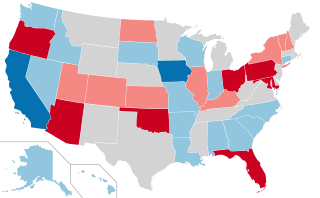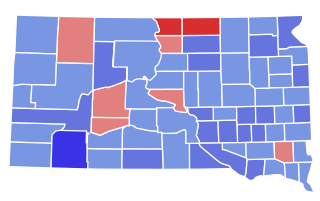
The 1968 United States Senate elections were elections for the United States Senate. Held on November 5, the 34 seats of Class 3 were contested in regular elections. They coincided with the presidential election of the same year. The Republicans picked up five net seats in the Senate. This saw Republicans win a Senate seat in Florida for the first time since Reconstruction.

Harold Everett Hughes was an American politician who served as the 36th Governor of Iowa from 1963 until 1969, and a United States senator from Iowa from 1969 until 1975. He began his political career as a Republican but changed his affiliation to the Democratic Party in 1962.
The Iowa Democratic Party (IDP) is the affiliate of the Democratic Party in the U.S. state of Iowa.

Elections in the U.S. state of New Hampshire are held at national, state and local level. The state holds the first presidential primary in the national cycle. Elections for a range of state positions coincide with biennial elections for the House of Representatives.

The Ohio general elections, 2010 were held on November 2, 2010 throughout Ohio. Primary elections took place on May 4, 2010.

The 1890–91 United States Senate elections were held on various dates in various states. As these U.S. Senate elections were prior to the ratification of the Seventeenth Amendment in 1913, senators were chosen by state legislatures. Senators were elected over a wide range of time throughout 1890 and 1891, and a seat may have been filled months late or remained vacant due to legislative deadlock. In these elections, terms were up for the senators in Class 3.

The 1916 United States presidential election in Pennsylvania took place on November 7, 1916, as part of the 1916 United States presidential election. Voters chose 38 representatives, or electors to the Electoral College, who voted for president and vice president.

The 1916 United States presidential election in Montana took place on November 7, 1916 a part of the 1916 United States presidential election. Voters chose four representatives, or electors to the Electoral College, who voted for president and vice president.

The 1968 United States Senate election in Maryland was held on November 5, 1968. Incumbent Democratic U.S. Senator Daniel Brewster ran for re-election to a second term in office but was defeated by Republican U.S. Representative Charles Mathias. Mathias may have benefited from the campaign of George P. Mahoney, the 1966 Democratic nominee for Governor of Maryland, who ran on the George Wallace American Independent ticket and garnered a significant chunk of the vote.

The 1986 South Dakota gubernatorial election was held on November 4, 1986 to elect the Governor of South Dakota. Incumbent Bill Janklow was term-limited, so the field for the new governor was open. Republican nominee George S. Mickelson was elected, defeating Democratic nominee Ralph Lars Herseth.

The 1948 United States Senate election in Iowa took place on November 2, 1948. Incumbent Republican Senator George A. Wilson ran for re-election to a second term but was defeated by Democratic former Senator Guy Gillette.

The 1950 United States Senate election in Iowa took place on November 7, 1950. Incumbent Republican Senator Bourke B. Hickenlooper was re-elected to a second term in office over Democratic U.S. Undersecretary of Agriculture Albert J. Loveland.

The 1944 United States Senate election in Iowa took place on November 7, 1944. Incumbent Democratic Senator Guy M. Gillette ran for a second full term in office but was defeated by Republican Governor Bourke B. Hickenlooper.

Since Alaska's admission to the Union in January 1959, it has participated in 16 United States presidential elections, always having 3 electoral votes. In the 1960 presidential election, Alaska was narrowly won by the Republican Party's candidate and incumbent vice president Richard Nixon, defeating the Democratic Party's candidate John F. Kennedy by a margin of just 1.88%. In the 1964 presidential election, the Democratic Party's candidate Lyndon B. Johnson won Alaska in a national Democratic landslide victory. Since the 1964 election, Alaska has been won by the Republican Party in every presidential election.

The 1968 United States presidential election in Delaware was held on November 5, 1968. State voters chose three representatives, or electors to the Electoral College, who voted for president and vice president.

The 1954 United States Senate election in Iowa took place on November 2, 1954. Incumbent Democratic Senator Guy Gillette ran for re-election to a second term but was defeated by Republican U.S. Representative Thomas E. Martin.

The 1962 United States Senate election in Iowa took place on November 6, 1962. Incumbent Republican Senator Bourke B. Hickenlooper was re-elected to a fourth term in office over Democrat E.B. Smith.

The 1972 United States Senate election in South Dakota took place on November 7, 1972, concurrently with the U.S. presidential election as well as other elections to the United States Senate in other states as well as elections to the United States House of Representatives and various state and local elections.

The 1974 United States Senate election in Iowa took place on November 5, 1974. Incumbent Democratic U.S. Senator Harold E. Hughes retired. The open seat was won by U.S. Representative John C. Culver, defeating Republican State Representative David M. Stanley. As of 2023, this was the most recent election in which a Democrat, or anyone other than Chuck Grassley, has won the Class 3 Senate seat in Iowa.

The 1916 United States presidential election in Iowa took place on November 7, 1916, as part of the 1916 United States presidential election which was held throughout all contemporary 48 states. Voters chose 13 representatives, or electors to the Electoral College, who voted for president and vice president.



















